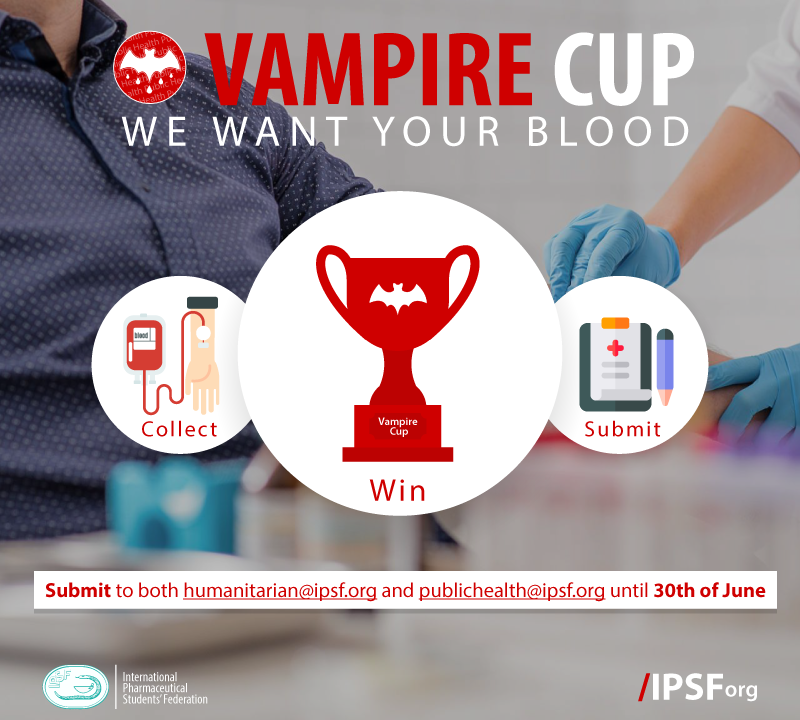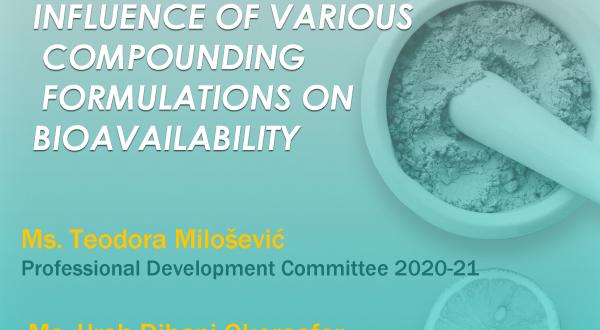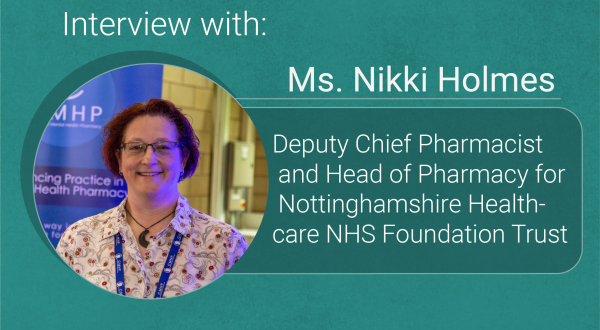
Vampire Cup Booklet
Introduction
The Vampire Cup campaign is an international blood donation drive. Many people would not be alive today if donors had not generously given their blood.
How the Vampire Cup was born?
The Vampire Cup was first organized by the National Australian Pharmaceutical Students’ Association (NAPSA) in 2006-2007. It is a blood donation competition between local associations. Pharmacy students donate their blood at the Australian Red Cross Blood Service blood bank or at a donation bus provided by the Red Cross on the university campus. At the end of the event, the total amount of blood donated is reported to the NAPSA executive by its local associations. The winner is announced during their national event, the NAPSA Congress.
IPSF saw great potential in this event and, with the approval of NAPSA, the Vampire Cup was launched globally. Now, Vampire Cup is an international blood donation competition among all the IPSF associations as the only official campaign for Humanitarian and Human Rights.
What I will find in this booklet?
In this booklet, you will find out more about the donation process, tips on how to organize a blood drive and contend for the vampire cup! It will also guide you on how to use the toolkit provided by us. Even if you aren’t participating in the competition, we would like you to encourage your association to organize a blood donation awareness campaign. In this way, you are contributing to an extremely meaningful cause.
Please keep in mind that the information provided in this booklet and promotional materials are based on international recommendations from the World Health Organization (WHO).
Each national blood transfusion system is responsible for defining their own guidelines for a blood drive as well as the requirements for donors. So do not be surprised if some of the information stated here is different to your country.
Our aim with this booklet is to give you basic information about the blood donation process so it can help you organize any activity related to it. However, you should adapt the information within these guidelines to your own context when necessary.
Aims
-
To raise public awareness about the blood donation process.
-
To increase blood donation campaigns among our members.
-
To provide valuable information to possible blood donors about the blood donation process.
-
To encourage people to donate.
-
To provide a platform to celebrate and thank those who donate for altruistic reasons.
-
To raise awareness about the importance of donating multiple times in order to maintain a sufficient supply of blood.
-
To spread humanitarian values among our members such as altruism, respect, kindness and empathy.
-
To contribute towards the 2020 goal: for all countries to obtain 100% of blood supplies from voluntary, unpaid donors by the year 2020.
Steps of Donation
Understanding how the blood donation process functions should be your first step when planning your own event. This will not only provide the best information to blood donors, but also allows you to liaise with the blood transfusion service you are partnering with. The blood donation process typically functions as so:
-
Registration process, donors are asked to provide personal information such as age, weight, ID number and date of birth.
-
You may also be required to fill in a medical history survey that assesses whether you fulfill all the requirements to donate.
-
Blood donor counseling involves a confidential dialogue between a blood donor and a trained staff member from the blood transfusion service. Personal questions may be asked in order to evaluate the risk of transmitting any transfusion-transmissible infections. It is also an opportunity for you to ask any questions you may have. You will also sign an informed consent form.
-
The finger prick test measures your hemoglobin levels to ensure they are in the acceptable range that allows you to donate. Other vital signs such as blood pressure and pulse may be measured as well.
-
The donation is performed by a professional and usually takes 15-20 minutes. Afterwards, you are asked to remain behind for a few more minutes to see if you have any problems after the donation.
-
Refreshments such as a soft drink and a snack are usually provided.
How to organize a blood drive (suggested timeline)
2 months before:
-
Recruit a team and form an action plan: make sure that you gather together a group of people with a variety of skills that can contribute to the success of the campaign. Structure your team according to the needs of the project. For example, the team can be divided into groups responsible for different tasks:
-
Logistics: maintaining contact with the blood bank organization and ensuring you provide them with everything they need, obtaining any necessary authorization for holding the blood drive (especially if it is held at your university)
-
Advertising: responsible for the promotion of the event including the design of posters and developing social media strategies or other ways to promote the event
-
Awareness: responsible for an awareness campaign about blood donation. It is proven that person-to-person contact is the best way to recruit blood donors
-
Sponsorship: to find sponsors who could help with any activity related to the event. Consider giving a meaningful gift to the blood donors at the end of their donation as well.
-
Set a date: discuss possible dates for the blood drive. When discussing dates, make sure you choose a date that doesn’t overlap with exams or work assignments. Students need to be relaxed and have time to donate blood.
-
Search for blood bank organizations: Some of your most accessible resources are your local Red Cross and blood transfusion centers. These organizations can provide you with plenty of support including staffing, logistics and simply getting the word out. They are accustomed to running blood drives and can help you in every step of the way to ensure a successful blood drive.
-
After finding an appropriate blood bank, present the possible dates to the organization and decide on a definite date. Ask them what they need for the campaign and if they can provide you with guidance and promotion materials. Maintain contact regularly and define some common strategies.
-
Location: One of the first considerations to ensure the success of you drive is to choose a good location. Preferably, the blood donation campaign should be mobile as it is more convenient:
-
If the campaign is held at the blood bank organization, make sure you promote it well and provide your target audience with the information they need. For example, you can distribute flyers with an explanation of how to reach the blood bank by public transportation or even by car.
-
If you host a mobile blood drive, your goal should be to find a place that will be centrally accessible to the maximum number of participants. Your location should also meet the criteria for safe and proper blood collections and be able to accommodate the appropriate capacity. It should be well ventilated with multiple outlets and good lighting. Ground floor or access to an elevator is important, as blood drive equipment is heavy. Depending on the organization, there is also the possibility of conducting the blood drive in a blood mobile vehicle.
1-2 months before:
-
Face-to-face meeting with the blood transfusion service at the suggested location:
By this stage, most of the details with the partner organization should be arranged. It is recommended that you schedule a personal meeting with the blood transfusion service to show them the location where the blood drive is going to be held. This will allow for them to establish with you for example, the path of the donor, and anything else you will need to organize in the area (for example, tables, chairs and power outlets). This is your opportunity to ask any questions about the blood donation process! Present your plan to them (including the communication strategy). They are experienced in the process so they will definitely guide you or provide you with suggestions for improvement. In case you need a letter from them to obtain your faculty’s permission to hold the blood drive, this is the perfect opportunity to ask for it.
-
Meeting with your team: Make sure to have regular meetings with your team, to ensure everything is running smoothly. Certainly, after meeting with the blood transfusion service you will have more details to share with your team.
-
Development and preparation of a promotion strategy: This is crucial for the success of the event. You can promote the event on social media, put up posters, produce flyers or even organize an awareness activity about blood donation. Here are some suggestions:
Awareness campaign: set a day to raise awareness about blood donation. This can be achieved through various strategies. Using this link, you will find some global facts about blood donation that may help you understand the necessity of donating blood. There are some details that need to be shared with your target audience, especially prospective donors. Some of this information includes the following:
-
General information, such as what is expected on the day of the blood donation, how it is organized and what each step consists of. Some tips on how to prepare for donation can also be shared! Please refer to the pre-donation flyer we have prepared
-
Share the rights and responsibilities of blood donors. It is important for any prospective donor to understand their responsibilities and the need to reply honestly to questions the blood transfusion service may ask. Please refer to the responsibilities & rights of donors flyer we have prepared
-
Answer the questions or concerns potential donors may have. There are many myths about the process that might influence their decision to donate. In addition to this, some people are unsure of the requirements for donating.
Please refer to the FAQs for blood donors flashcards. In this document, you have answers to many questions or doubts people often have regarding the blood donation process. You can print off these flashcards and challenge the audience with them. (You can, for example, place the cards on a table with the questions facing up so the public has an opportunity to read the explanations carefully). This allows for the audience to spot the questions that are most relevant to them. For example, if someone is taking medication, they will easily spot the question, “What if I am taking a medication? Can I donate?” Even if you aren’t able to print them, you can pass this file to the volunteers who are helping you organizing the blood drive. It can help them to reply many concerns or doubts possible donors have, and help them recruit donors.
Other suggestions:
-
Ideally, donors should register in advance to ensure smoother scheduling on the day of the event. At the awareness campaign, you can provide a sign-up or time slot document that will allow donors to choose a time that works best for them and ensures a more consistent flow throughout the day. It helps the blood bank organize how many staff is needed on the day. Having the email addresses of possible donors can be used for sending reminders in the days leading up to the campaign. Alternatively, you can also share an online registration form!
Hold a photo booth where people can take pictures with phrases about blood donation or other accessories (for example, drops of blood, superhero capes or masks, vampire figurines with slogans of the campaign “We Want Your Blood”). Ask participants to share these photos on social media with creative hashtags. Another way would be to publish the photo booth album on your official social media accounts and in the description of the album; you can put all the information about the blood donation drive (such as date and location). Don’t forget to tag the people that are featured in the photos, so it reaches more people!
Promotion
-
Ask for the collaboration of some professors. They can talk to their students about the event and encourage them to donate.
-
Ask any possible sponsors to share their event within their communication channels.
-
Hang posters throughout the university and other surroundings.
-
Ask for your university to promote your blood drive through their official site. Contact other platforms within the region, such as TV/radio/newspaper/websites.
-
Create a Facebook event with all the necessary information. Post regularly on the Facebook event page and invite your acquaintances to it.
-
Also for social media, you can ask your team to use the frame provided by us (you can find it in toolkit folder) and include in the description the important blood drive information (such as date, location, etc.).
1-2 weeks before:
Complete any final checks and preparation. More emails should be sent out and more promotion conducted. Confirm your location and ensure that the team is ready for the project.
During the campaign:
-
Final briefing of the team.
-
Ensure all locations are manned.
-
Ensure enough information is available for people who ask for it (put up arrows which indicate the path to the location). On the day of the event, volunteers along with organization representatives can help donors through the registration process.
-
In the case of a mobile blood drive, set up the room before the blood drive staff arrives. Make sure to meet with the blood bank staff 1-2 hours before the event starts and assist them with anything they require.
-
Don’t forget to record how many total units of blood were donated!
-
Make sure that blood donors feel appreciated and provide them with post-donation information. Although many donors don’t experience any adverse reactions after donating, it is still important to give them some preventive measures after donating. - Please refer to the post-donation flyer we have prepared.
After the campaign:
Announce the campaign results, along with a thank you note to all participants. Make your donors feel appreciated.
Have a final briefing with your team to evaluate how the campaign went, making a list of the positives as well as the things that could have been better.
Additional information:
Check the FAQs document for the competition, which has the registration forms.
Check the toolkit folder to download the tracker forms.
If you need more info, please contact:
-
Ms. Lama Gaafar (Humanitarian Coordinator): [email protected]
-
Mr. See Jia Ong (Chairperson of Public Health): [email protected]
References:
http://www.who.int/mediacentre/factsheets/fs279/en/
http://www.who.int/bloodsafety/publications/UniversalAccesstoSafeBT.pdf?ua=1
http://www.who.int/bloodsafety/transfusion_services/estimation_presentations.pdf?ua=1
http://paro.ipsf.org/publichealth/paro-focus/vampire-cup-campaign/
http://publichealth.ipsf.org/vampire-cup/
http://americanpregnancy.org/pregnancy-concerns/blood-transfusions-during-pregnancy/
http://www.mahasbtc.com/indications-blood-transfusion
https://www.organicfacts.net/health-benefits/other/blood-donation.html
http://www.lifehack.org/articles/lifestyle/5-health-benefits-donating-blood.html
http://www.medscape.com/viewarticle/756203
http://www.who.int/worldblooddonorday/about/objectives/en/
http://www.redcrossblood.org/learn-about-blood/blood-facts-and-statistics
http://www.dakminnbloodbank.org/media/BLOOD_DRIVE_MANUAL.pdf
http://www.redcrossblood.org/learn-about-blood/blood-facts-and-statistics
https://www.blood.co.uk/why-give-blood/
https://nhsbtdbe.blob.core.windows.net/umbraco-assets-blood/1104/donor-winter2015-f1.pdf
http://www.indiacelebrating.com/events/world-blood-donor-day/



